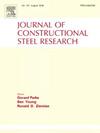基坑工程中预制h型钢支架的偏心受压特性
IF 4
2区 工程技术
Q1 CONSTRUCTION & BUILDING TECHNOLOGY
引用次数: 0
摘要
为明确预制h型钢支撑结构的关键性能,促进绿色低碳基坑支护体系的发展,对可回收和可重复使用的h型钢支撑单腿试件进行了压缩试验,包括2个同心加载试件和2个偏心加载试件。建立了可靠的有限元分析模型进行参数分析。基于试验和有限元分析结果,分析了试件的破坏模式、荷载-位移曲线、挠度曲线和应变响应。结果表明:试件在轴向和偏心受压下的破坏模式相似,侧向变形增大导致整体失稳;剪接节点外侧h型钢法兰发生局部屈曲。当支撑段不稳定时,盖板最外层螺栓和端板螺栓有断裂的危险。偏心距为50 mm时,试件的极限强度较低,面外变形较大。考虑长轴偏心后,临界稳定载荷减小14.74%,面外变形增大40.58%。考虑小轴偏心率,这些值分别为48.84%和340.71%。参数分析还表明,长度、截面尺寸和偏心距是影响支撑段刚度和极限强度的主要因素。制定的规范中挠曲和压缩相互作用方程适用于支承段,欧洲规范3比AISC360和GB50017-2017更适用于支承段。本文章由计算机程序翻译,如有差异,请以英文原文为准。
Eccentric compression behaviour of precast H-shaped steel support in foundation pit engineering
To clarify the key performance of precast H-shaped steel support structures and promote the development of green, low-carbon foundation pit support systems, compression tests were conducted on recyclable and reusable H-shaped steel support single-leg specimens, including two concentrically-loaded specimens and two eccentrically-loaded specimens. A reliable finite element analysis model was established for parametric analysis. The failure modes, load-displacement curves, deflection curves, and strain responses of the specimens were analysed based on experimental and finite element analysis results. The results indicated that the failure modes of the specimens under both axial and eccentric compression were similar, with increased lateral deformation leading to overall instability. Local buckling occurred at the outer H-shaped steel flange of the spliced node. The outermost bolts of the cover plate and the end plate bolts were at risk of breaking, when the support segment became unstable. Eccentrically-loaded specimens with a 50-mm eccentricity exhibited lower ultimate strength and higher out-of-plane deformation compared to concentrically-loaded specimens. Considering the major-axis eccentricity, the critical stable load decreased by 14.74 % and the out-of-plane deformation increased by 40.58 %. Considering the minor-axis eccentricity, these values were 48.84 % and 340.71 %, respectively. The parametric analysis also revealed that the length, section size, and eccentricity were the primary factors affecting the stiffness and ultimate strength of the support segments. The interaction equations for flexure and compression in the developed codes were applicable to support segments, and Eurocode 3 was more suitable than AISC360 and GB50017–2017.
求助全文
通过发布文献求助,成功后即可免费获取论文全文。
去求助
来源期刊

Journal of Constructional Steel Research
工程技术-工程:土木
CiteScore
7.90
自引率
19.50%
发文量
550
审稿时长
46 days
期刊介绍:
The Journal of Constructional Steel Research provides an international forum for the presentation and discussion of the latest developments in structural steel research and their applications. It is aimed not only at researchers but also at those likely to be most affected by research results, i.e. designers and fabricators. Original papers of a high standard dealing with all aspects of steel research including theoretical and experimental research on elements, assemblages, connection and material properties are considered for publication.
 求助内容:
求助内容: 应助结果提醒方式:
应助结果提醒方式:


